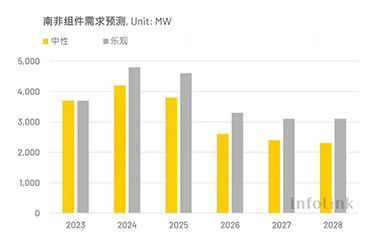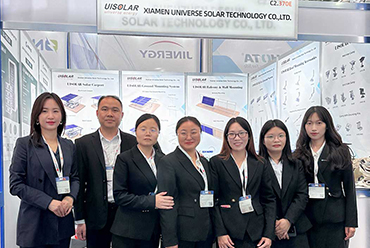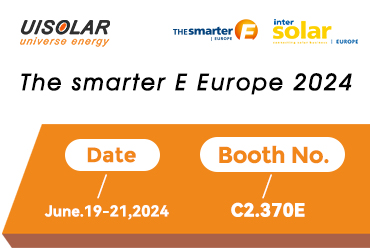
We are thrilled to invite all solar energy professionals and enthusiasts to visit us at Intersolar South America 2024, the most significant exhibition in the region dedicated to the solar industry. This prestigious event will take place from August 27th to 29th, 2024, at the Expo Center Norte in São Paulo, Brazil. Why Attend? Intersolar South America is a premier platform that brings together the most influential players in the solar energy sector. It provides an exceptional opportunity to connect with industry leaders, discover cutting-edge technologies, and discuss the latest trends in solar power. Visit Us at Booth No. B1.09 We are excited to announce that UISOLAR will be showcasing our latest innovations and solutions at Booth No. B1.09. Whether you're interested in exploring new business opportunities, enhancing your network, or simply staying informed about the advancements in solar technology, our booth is the place to be! What to Expect? · Innovative Solutions: Discover our newest solar energy products designed to meet the growing demand for sustainable energy. · Expert Insights: Engage with our team of experts who will be on hand to answer your questions and provide insights into the future of solar energy. · Networking Opportunities: Connect with other professionals and organizations from around the world who are as passionate about solar energy as you are. Don’t miss out on this incredible opportunity to be part of South America's leading solar energy event. Mark your calendar for August 27-29, 2024, and make sure to visit us at Booth No. B1.09 at Expo Center Norte. We look forward to welcoming you and exploring how we can collaborate to drive the solar industry forward together! See you in São Paulo!
Read More
On August 16, 2024, the Australian Anti-Dumping Commission issued Announcement No. 2024/046 stating that the anti-dumping and countervailing measures on aluminum extrusions imported from China will expire on October 28, 2025. Stakeholders should submit applications for sunset review investigations before October 15, 2024. If no application is received before the above deadline, the anti-dumping and countervailing measures on the Chinese products involved will be terminated after the expiration. On June 24, 2009, Australia launched an anti-dumping and countervailing investigation on aluminum extrusions imported from China. On October 28, 2010, Australia made an affirmative final ruling on the case, ruling that the dumping margin of the products involved was 2.7% to 25.7% and the subsidy margin was 3.8% to 18.4%. On April 14, 2014, the Australian Anti-Dumping Commission issued Announcement No. 2014/31, initiating an anti-circumvention investigation on aluminum extrusions imported from China. On February 19, 2015, the Australian Anti-Dumping Commission issued Announcement No. 2015/17, making an affirmative final ruling on the case. On April 24, 2015, the Australian Anti-Dumping Commission issued Announcement No. 2015/048, initiating the first anti-dumping and countervailing sunset review investigation on aluminum profiles imported from China. On October 20, 2015, the Australian Anti-Dumping Commission issued Announcement No. 2015/125, making the first anti-dumping and countervailing sunset review affirmative final ruling on aluminum profiles imported from China. On February 13, 2020, the Australian Anti-Dumping Commission issued Announcement No. 2020/017, initiating the second anti-dumping and countervailing sunset review investigation on aluminum profiles imported from China. On October 15, 2020, the Australian Anti-Dumping Commission issued Announcement No. 2020/103, making an affirmative final ruling on the sunset review of the case. The Australian customs codes for the products involved are 7604.10.00.06, 7604.21.00.07, 7604.21.00.08, 7604.29.00.09, 7604.29.00.10, 7608.10.00.09, 7608.20.00.10, 7610.10.00.12 and 7610.90.00.13.
Read More
In recent years, due to the aging and poor management of the power generation facilities of the state-owned power company ESKOM, South Africa is facing a worsening power crisis. Long-term large-scale power rationing has caused serious losses to the country's economy. Against this background, South Africa has turned its attention to renewable energy including photovoltaics. South Africa's photovoltaic policy and market overview According to ESKOM's data, by the end of 2023, South Africa's cumulative photovoltaic installed capacity will be about 7.3 GW, of which distributed projects account for about 5 GW and centralized projects account for about 2.3 GW. In order to fill the gradually widening power gap, the South African government has proposed a series of policies to promote the development of photovoltaics. First, let's look at distributed projects. From March 2023 to March 2024, the South African government implemented tax breaks for household photovoltaics. As long as photovoltaic modules above 275 W are installed, a tax rebate of up to 25% can be received, and each person can get a maximum tax rebate of 15,000 rand (about US$795). In addition, in August 2023, South Africa issued the Energy Bounce Back Scheme (EBB), where households and small and medium-sized enterprises can apply to banks for loans of up to 300,000 rand (about 15,900 US dollars) and 10 million rand (about 530,000 US dollars) respectively, for the installation of photovoltaic modules, energy storage batteries and other equipment. In terms of centralized projects, South Africa began to implement the Renewable Energy Independent Power Producer Procurement Programme (REIPPPP) in 2011, which is the main source of centralized installations in South Africa. As of 2023, six rounds of bidding have been completed. The latest seventh round of bidding was originally expected to end in April 2024. However, at the end of May 2024, the government announced that the deadline for bidding will be postponed to August. On the other hand, South Africa also provides tax breaks for large-scale renewable energy projects. For investment projects from March 2023 to March 2025, companies can apply for a tax rebate of up to 125% on capital expenditures in the first year. In general, due to large-scale power restrictions and rising electricity prices, supplemented by policy support, South Africa's photovoltaic installations are mainly distributed projects for self-generation and self-use. In 2023, South Africa will add 2.5 GW of distributed installations, compared with 1.7 GW in 2022, a year-on-year increase of 47%. In contrast, South Africa's centralized installations have stagnated. Taking the fifth round of REIPPPP tendered in 2021 as an example, many projects were originally planned to be connected to the grid in 2023, but due to lengthy financing and administrative processes, they were forced to postpone their production until after 2024. In addition, ESKOM's insufficient absorption capacity is als...
Read More
Intersolar is the world's largest solar technology trade fair and the number one meeting point for everyone in the solar industry. We-UISOLAR-Old solar racking company attend Intersolar Europe 2024 like previous years. Exhibitions and conferences are held in the most influential markets around the world and it currently has intersolar in Europe, the USA, India, South America and China. It is the most important display platform for manufacturers, suppliers, wholesalers and service providers. The Smarter E offers exhibitors and visitors a full range of energy-related topics. smart E consists of four separate shows (Intersolar Europe,ees Europe, Power2Drive Europe and EM-Power), each with a clear industry focus. At the same time, the links between products and themes that are very important in the field of energy are well represented through the interplay of the exhibition. Under the slogan "Connecting the Solar Business," it brings together individuals and companies from around the world with the aim of increasing the share of solar in our energy supply. Focus on photovoltaic, photothermal technology and solar power plants. Since its inception, it has become the most important meeting point for manufacturers, suppliers, distributors and service providers in the solar industry. The concurrent conference integrates selected exhibition topics, showcasing international markets, large power plants, financing and cutting-edge technologies.
Read More
The Dragon Boat Festival, also called the Duanwu Festival, is celebrated on the fifth day of the fifth month according to the Chinese calendar. This festival is to commemorate the death of QU Yuan, an upright and honest poet and statesman who is said to have committed suicide by drowning himself in a river. The most important activity of this festival is the Dragon Boat races. It symbolizes people' s attempts to rescue Qu Yuan. In the current period, these races also demonstrate the virtues of cooperation and teamwork. Besides, the festival has also been marked by eating zong zi (glutinous rice). Zong zi is made of glutinous rice stuffed with different fillings and wrapped in bamboo or reed leaves. People who mourned the death of Qu threw Zong zi into the river to feed his ghost every year. With the changes of the times, the memorial turns to be a time for protection from evil and disease for the rest of year. People will hang healthy herbs on the front door to clear the bad luck of the house. Although the significance of the festival might be different with the past, it still gives the observer an opportunity to glimpse a part of the rich Chinese cultural heritage. Our holiday period is from June.8th to June.10th. If you want to inquire about our products, you are welcome to leave us a message and we will reply to you as soon as possible. UISOLAR provides you with professional and high-quality solar racking. Solar roof mounting, ground mounting, solar carports are all we can do. OEM and ODM are also available. UISOLAR and all staff wish everyone a happy and safe Dragon Boat Festival!
Read More
Photovoltaic is an industry with a very high degree of marketization, and market-oriented means are more suitable for promoting the development of the industry. This is also one of the reasons why China's photovoltaic industry leads the world today. As an indispensable force in the global photovoltaic market, the advantages of Chinese photovoltaic companies will not disappear in an instant. Chinese photovoltaic companies look forward to fair and reasonable trade relations and continue to contribute Chinese solutions to the development of the global green industry. Recently, the dynamic changes in the market value rankings of global photovoltaic listed companies have attracted the attention of the international market. According to Bloomberg, on May 17, the market value of First Solar, a US photovoltaic module manufacturer, surpassed Sungrow Power Supply to become the world's most valuable photovoltaic company. As of May 24, First Solar's market value was approximately US$26.7 billion (approximately RMB 193.7 billion), Sungrow Power Supply ranked second with a market value of RMB 150.2 billion, and Longi Green Energy Technology ranked third with a market value of RMB 142.2 billion. This is the first time since 2018 that a US photovoltaic company has topped the global photovoltaic company market value list. For a time, there were mixed voices in the international market that "Chinese photovoltaic companies suffered a Waterloo and their competitiveness declined." However, in fact, the market value of American photovoltaic companies represented by First Solar has jumped, relying on American trade protectionism, which is to impose tariffs on China while providing subsidies to local manufacturers. Chinese photovoltaic companies are not afraid of competition. Photovoltaic is an industry with a very high degree of marketization, and market-oriented means are more suitable for promoting the development of the industry. This is also one of the reasons why China's photovoltaic industry leads the world today. As an indispensable force in the global photovoltaic market, the advantages of Chinese photovoltaic companies will not disappear in an instant. Chinese photovoltaic companies look forward to fair and reasonable trade relations and continue to contribute Chinese solutions to the development of the global green industry. And we will attend the Inter Solar Show in Munich German at 17th-19th June. Welcome to our booth for further cooperation!
Read More online service
online service +86 (0592)5663849
+86 (0592)5663849 sales@uisolar.com
sales@uisolar.com solar-mount.au
solar-mount.au